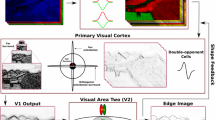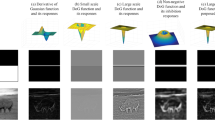Abstract
Recently, we have developed a nonlinear circuit for oriented contrast detection, which is motivated by main architectural stages in mammalian visual system. In this work we examine how on- and off- contrast axe combined before feeding into the nonlinear circuit. We propose a mechanism of dominating opponent inhibition (DOI), where each pathway receives stronger weighted inhibitory input from the opponent domain. We employ an analysis of a simplified circuit accompanied by simulations with systematic parameter variations. Results show that DOI makes the circuit robust to noise, largely independent of the amount of noise added. Finally, we demonstrate the capabilities of the model by processing synthetic as well as natural images. Results are compared to a linear circuit, equivalent to a first order Gaussian derivative and to the nonlinear model without DOI, showing that the new circuit largely suppresses spurious noise, while remaining sensitive to contrast variation at edges.
Supported by DFG(SFB 527).
Access this chapter
Tax calculation will be finalised at checkout
Purchases are for personal use only
Preview
Unable to display preview. Download preview PDF.
Similar content being viewed by others
References
J. Canny. A computational approach to edge detection. IEEE PAMI, 8 (6): 679–698, 1986.
D. Ferster. The synaptic inputs to simple cells in the cat visual cortex. In D. Lam and C. Gilbert, editors, Neural mechanisms of visual perception, chapter 3, pages 63 – 85. Portfolio Publ. Co., The Woodlands, Texas, 1989.
M. D. Heath, S. Sarkar, T. Sanocki, and K. W. Bowyer. A robust visual method for assessing the relative performance of edge-detection algorithms. IEEE PAMI, 19 (12): 1338–1359, 1997.
P. Heggelund. Quantitative studies of enhancement and suppression zones in the receptive field of simple cells in cat striate cortex. J. Physiol., 373: 293–310, 1986.
D. H. Hubel and T. N. Wiesel. Receptive fields, binocular interaction and functional architecture in the cat’s visual cortex. J. Physiol., 160: 106–154, 1962.
D. Lee. Coping with discontinuities in computer vision: Their detection, classifi-cation, and measurement. IEEE PAMI, 12 (4): 321–344, 1990.
D. Marr. Vision. W. H. Freeman k Co., San Francisco, 1982.
D. Marr and E. Hildreth. Theory of edge detection. Proc. R. Soc. London (B), 207: 187–217, 1980.
H. Neumann, L. Pessoa, and T. Hansen. Interaction of ON and OFF pathways for visual contrast measurement. Biol. Cybern. To appear.
A. Papoulis. Probability, Random Variables and Stochastic Processes. McGraw- Hill, 1965.
L. Pessoa, E. Mingolla, and H. Neumann. A contrast- and luminance-driven multiscale network model of brightness perception. Vis. Res., 35 (15): 2201–2223, 1995.
I. E. Sobel. Camera Models and Machine Perception. PhD thesis, Stanford Univ., 1970.
Author information
Authors and Affiliations
Editor information
Editors and Affiliations
Rights and permissions
Copyright information
© 1999 Springer-Verlag Berlin Heidelberg
About this paper
Cite this paper
Hansen, T., Baratoff, G., Neumann, H. (1999). Dominating Opponent Inhibition of On and Off Pathways for Robust Contrast Detection. In: Förstner, W., Buhmann, J.M., Faber, A., Faber, P. (eds) Mustererkennung 1999. Informatik aktuell. Springer, Berlin, Heidelberg. https://doi.org/10.1007/978-3-642-60243-6_27
Download citation
DOI: https://doi.org/10.1007/978-3-642-60243-6_27
Publisher Name: Springer, Berlin, Heidelberg
Print ISBN: 978-3-540-66381-2
Online ISBN: 978-3-642-60243-6
eBook Packages: Springer Book Archive




